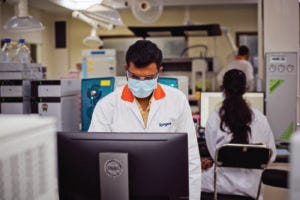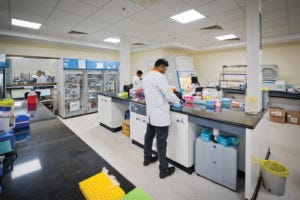- Sponsored Content
Detection and Quantitation of Process-Related ImpuritiesDetection and Quantitation of Process-Related Impurities
November 16, 2023
Sponsored by Syngene
 Detection and quantitation of process-related impurities are important to quality control in biopharmaceutical manufacturing. Process-related impurities can have a significant impact on pharmaceutical product quality, safety, and efficacy. Such impurities can be generated during a biomanufacturing process and come from product degradation, starting materials and reagents, by-products, storage conditions, and contamination. Without proper detection and quantification, process-related impurities can cause adverse effects in patients.
Detection and quantitation of process-related impurities are important to quality control in biopharmaceutical manufacturing. Process-related impurities can have a significant impact on pharmaceutical product quality, safety, and efficacy. Such impurities can be generated during a biomanufacturing process and come from product degradation, starting materials and reagents, by-products, storage conditions, and contamination. Without proper detection and quantification, process-related impurities can cause adverse effects in patients.
Guidelines from the International Council for Harmonisation of Technical Requirements for Pharmaceuticals for Human Use (ICH) make quality by design (QbD) an essential requirement during pharmaceutical development. The ICH Q8–Q10 documents outline a systematic approach to pharmaceutical development, emphasizing the crucial importance of understanding product and process parameters to ensure product quality (1–3). Below, I highlight key challenges in the detection and quantitation of process-related impurities — including nitrosamine impurities — and Syngene’s capabilities and solutions to address them.
Detection and Quantification of Process-Related Impurities
A number of difficulties can arise in detection and quantification of bioprocess-related impurities using the broad array of analytical techniques available. Issues can be method, process, product, or impurity specific.
Method Sensitivity and Selectivity: Some impurities can be present at very low concentrations, making their detection and quantification difficult. Specialized techniques including preconcentration and derivatization might be necessary to improve an analytical method’s sensitivity. Technologies must be selective enough to distinguish the impurities from other components in a sample matrix (e.g., drug substance or formulation). Such selectivity can affect the performance of an analytical method. Matrix effects can interfere with separating and detecting impurities, ultimately necessitating additional steps to overcome the interference.
Impurity Identification: Identifying individual process-related impurities can be difficult, especially if they are unknown or have complex structures. Thus, orthogonal analytical techniques must be used to identify each impurity.
Validation: Analytical validation methods must be corroborated to ensure accuracy, precision, and reliability. Validation processes are time-consuming and resource-intensive and might require the use of reference materials or standards. A lack of standardized methods for detecting and quantifying process-related impurities can make evaluating results from different laboratories and studies difficult. Establishing standardized procedures and reference materials can help laboratories improve their method consistency and accuracy.
Cost: Some modern analytical technologies are expensive, requiring specialized equipment and/or expertise. Such factors can make those inaccessible to some laboratories or companies, limiting their ability to characterize fully the impurities in their drug substances or products.
 Service Solutions
Service Solutions
Detection and quantitation of process-related impurities increasingly require high-end analytical techniques used to separate, identify, and quantify impurities in a drug-substance or drug-product matrix. Syngene International’s services include providing the framework to identify critical quality attributes (CQAs) and finalize relevant process parameters during biopharmaceutical product development. During that process, our emphasis is on using risk-management tools such as failure modes and effects analysis (FMEA) and design of experiments (DoE) approaches to identify and control potential sources of variability in clients’ biomanufacturing processes. Those efforts, in turn, facilitate the analytical justification of product and process specifications.
Analytical Method Development: Syngene can help biopharmaceutical companies develop analytical methods for detecting and quantifying impurities in their drug substances and products. The global contract manufacturing organization (CMO) has expertise in a number of analytical techniques, including high-performance liquid chromatography (HPLC), gas chromatography (GC), nuclear magnetic resonance (NMR) spectroscopy, and high-resolution mass spectrometry (MS).
Impurity Identification and Profiling: Our laboratories use a number of analytical techniques — such as MS, NMR spectroscopy, and infrared (IR) spectroscopy — to identify unknown impurities in drug substances and drug products. We offer impurity profiling services to characterize those impurities fully, from identifying and quantifying them to assessing impurity profiles over time.
Validation and Transfer of Analytical Methods: Syngene can help clients validate their analytical methods to ensure that they will meet regulatory requirements in line with ICH guidelines (4). We can also transfer validated methods to clients’ laboratories, providing a standardized approach to impurity testing.
Stability Testing: Syngene can conduct pharmaceutical stability testing according to ICH recommendations, identifying impurities that can arise throughout the shelf life of drug substances and products.
Regulatory Support: We also offer regulatory support for impurity testing, including preparing regulatory submissions and taking part in interactions with regulatory agencies.
Nitrosamine Impurities
The recent and unexpected finding of nitrosamine impurities (probable human carcinogens) in pharmaceuticals such as angiotensin II receptor blockers (ARBs), ranitidine, nizatidine, and metformin, resulted in a large-scale recall of those drugs. Consequent to that finding, the US Food and Drug Administration (FDA) and its global regulatory counterparts issued guidance on this topic for active pharmaceutical ingredient (API) and drug-product manufacturers worldwide (5). The guidance describes appropriate actions that drug companies need to take to detect and prevent unacceptable levels of nitrosamine impurities in their pharmaceutical products.
Center of Excellence: Syngene operates a state-of-the-art facility for risk assessment, development, and validation of nitrosamine impurities in drug substances and drug products (see the box above). The facility supports nitrosamine testing of drug substances in line with formulation requirements for small-molecule APIs, key starting materials (KSMs), and product intermediates. Our internationally accredited analytical laboratories and highly skilled scientists ensure that all data generated comply with regulatory requirements.
Focus on Safety and Efficacy
Syngene has the expertise and capabilities, including state-of-the-art instrumentation, to provide comprehensive solutions for detection and quantitation of process-related impurities in both small-molecule and biologic therapeutics. We operate a state-of-the-art facility for risk assessment, development, and validation of nitrosamine impurities in drug substances and products. Highly sensitive and selective methods used in our laboratories enable accurate identification and quantitation of impurities, even those present at low levels. Using appropriate standards, controls, and validation procedures ensures both accuracy and reliability of our analytical results according to international regulatory guidelines. That regulatory compliance ensures successful development and manufacturing of safe and effective pharmaceutical and biopharmaceutical products for our clients.
References
1 ICH Q8(R2). Pharmaceutical Development. US Fed. Reg. 71(98) 2009; https://database.ich.org/sites/default/files/Q8%28R2%29%20Guideline.pdf.
2 ICH Q9(R1). Quality Risk Management. US Fed. Reg. 88(86) 2023: 28565–28566; https://database.ich.org/sites/default/files/ICH_Q9%28R1%29_Guideline_Step4_2023_0126_0.pdf.
3 ICH Q10. Pharmaceutical Quality System. US Fed. Reg. 74(66) 2009: 15990–15991; https://database.ich.org/sites/default/files/Q10%20Guideline.pdf.
4 ICH Q2(R1). Validation of Analytical Procedures: Text and Methodology. US Fed. Reg. 62(96) 1997: 27463–27467; https://database.ich.org/sites/default/files/Q2%28R1%29%20Guideline.pdf.
5 CDER. Control of Nitrosamine Impurities in Human Drugs: Guidance for Industry. US Food and Drug Administration: Rockville, MD, February 2021; https://www.fda.gov/media/141720/download.
Jai Kumar Keshwan is associate research director of analytical research development at Syngene International Ltd., Biocon Park, SEZ, Bommasandra Industrial Area – Phase IV, Jigani Link Road, Bangalore 560 099; [email protected];
https://www.syngene.com.
You May Also Like






